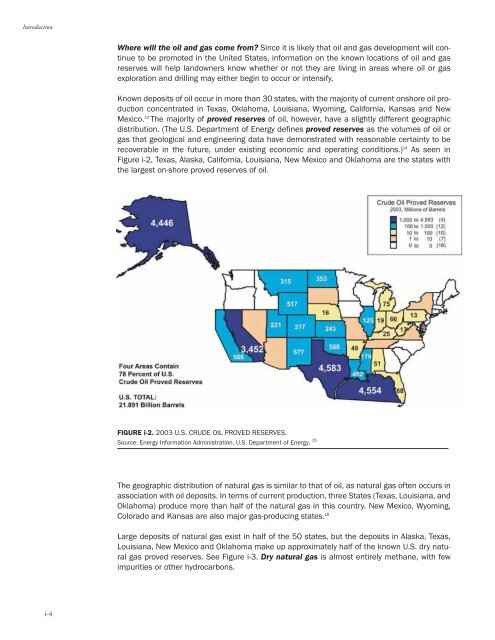- Page 1 and 2: Oil and Gas at Your Door? A Landown
- Page 3 and 4: About the Oil & Gas Accountability
- Page 5 and 6: Table of Contents Introduction What
- Page 7 and 8: Chapter III, Tips for Landowners Wh
- Page 9 and 10: Introduction Oil and gas developmen
- Page 11: For the oil we need, unless we choo
- Page 15 and 16: Do you own the minerals associated
- Page 17 and 18: Chapter I Oil and Gas Development a
- Page 19 and 20: TERMS AND CONCEPTS When natural gas
- Page 21 and 22: STAGES OF OIL & GAS DEVELOPMENT In
- Page 23 and 24: STAGES OF OIL & GAS DEVELOPMENT •
- Page 25 and 26: STAGES OF OIL & GAS DEVELOPMENT FIG
- Page 27 and 28: STAGES OF OIL & GAS DEVELOPMENT •
- Page 29 and 30: STAGES OF OIL & GAS DEVELOPMENT Sur
- Page 31 and 32: STAGES OF OIL & GAS DEVELOPMENT pan
- Page 33 and 34: STAGES OF OIL & GAS DEVELOPMENT Nex
- Page 35 and 36: STAGES OF OIL & GAS DEVELOPMENT One
- Page 37 and 38: STAGES OF OIL & GAS DEVELOPMENT Gat
- Page 39 and 40: STAGES OF OIL & GAS DEVELOPMENT Pro
- Page 41 and 42: STAGES OF OIL & GAS DEVELOPMENT PRO
- Page 43 and 44: STAGES OF OIL & GAS DEVELOPMENT pro
- Page 45 and 46: STAGES OF OIL & GAS DEVELOPMENT Plu
- Page 47 and 48: STAGES OF OIL & GAS DEVELOPMENT •
- Page 49 and 50: NON CONVENTIONAL OIL AND GAS FIGURE
- Page 51 and 52: NON CONVENTIONAL OIL AND GAS COALBE
- Page 53 and 54: NON CONVENTIONAL OIL AND GAS Cavita
- Page 55 and 56: NON CONVENTIONAL OIL AND GAS to pro
- Page 57 and 58: IMPACTS ASSOCIATED WITH OIL AND GAS
- Page 59 and 60: IMPACTS ASSOCIATED WITH OIL AND GAS
- Page 61 and 62: IMPACTS ASSOCIATED WITH OIL AND GAS
- Page 63 and 64:
IMPACTS ASSOCIATED WITH OIL AND GAS
- Page 65 and 66:
IMPACTS ASSOCIATED WITH OIL AND GAS
- Page 67 and 68:
IMPACTS ASSOCIATED WITH OIL AND GAS
- Page 69 and 70:
IMPACTS ASSOCIATED WITH OIL AND GAS
- Page 71 and 72:
IMPACTS ASSOCIATED WITH OIL AND GAS
- Page 73 and 74:
IMPACTS ASSOCIATED WITH OIL AND GAS
- Page 75 and 76:
IMPACTS ASSOCIATED WITH OIL AND GAS
- Page 77 and 78:
IMPACTS ASSOCIATED WITH OIL AND GAS
- Page 79 and 80:
ALTERNATIVE TECHNOLOGIES AND PRACTI
- Page 81 and 82:
ALTERNATIVE TECHNOLOGIES AND PRACTI
- Page 83 and 84:
STAGES OF OIL & GAS DEVELOPMENT The
- Page 85 and 86:
STAGES OF OIL & GAS DEVELOPMENT to
- Page 87 and 88:
STAGES OF OIL & GAS DEVELOPMENT FIG
- Page 89 and 90:
Chapter II Legal and Regulatory Iss
- Page 91 and 92:
Who Owns the Minerals Beneath Your
- Page 93 and 94:
WHO OWNS THE MINERALS BENEATH YOUR
- Page 95 and 96:
MINERAL VS SURFACE RIGHTS er, can b
- Page 97 and 98:
MINERAL VS SURFACE RIGHTS • In th
- Page 99 and 100:
REGULATIONS AND SURFACE OWNER PROTE
- Page 101 and 102:
Exploration Before a company can en
- Page 103 and 104:
REGULATIONS AND SURFACE OWNER PROTE
- Page 105 and 106:
REGULATIONS AND SURFACE OWNER PROTE
- Page 107 and 108:
REGULATIONS AND SURFACE OWNER PROTE
- Page 109 and 110:
Other Protections Statutes and regu
- Page 111 and 112:
REGULATIONS AND SURFACE OWNER PROTE
- Page 113 and 114:
face owner to participate in this o
- Page 115 and 116:
Chapter III Tips for Landowners WHA
- Page 117 and 118:
SURFACE USE AGREEMENTS Surface Use
- Page 119 and 120:
SURFACE USE AGREEMENTS Powder River
- Page 121 and 122:
SURFACE USE AGREEMENTS operations t
- Page 123 and 124:
SURFACE USE AGREEMENTS ment payment
- Page 125 and 126:
SURFACE USE AGREEMENTS Reported Com
- Page 127 and 128:
SURFACE USE AGREEMENTS Examples of
- Page 129 and 130:
SURFACE USE AGREEMENTS ed by this A
- Page 131 and 132:
SURFACE USE AGREEMENTS 12. Dry Hole
- Page 133 and 134:
SURFACE USE AGREEMENTS 25. Firearms
- Page 135 and 136:
SURFACE USE AGREEMENTS in whole or
- Page 137 and 138:
LEASING Annual Reclamation Requirem
- Page 139 and 140:
LEASING • Within the mineral leas
- Page 141 and 142:
LEASING • Requiring landowner app
- Page 143 and 144:
OTHER ACTIVITIES TO CONSIDER Push f
- Page 145 and 146:
OTHER ACTIVITIES TO CONSIDER analys
- Page 147 and 148:
FILE LAWSUITS amendment also requir
- Page 149 and 150:
FILE LAWSUITS Landowners are Winnin
- Page 151 and 152:
Chapter IV Landowner Stories As has
- Page 153 and 154:
1. CBM DESTROYS RETIREMENT DREAM By
- Page 155 and 156:
has never been a loss of vegetation
- Page 157 and 158:
Board came. They accused her of pou
- Page 159 and 160:
4. COUNTY OFFICIALS SAY RESIDENTS I
- Page 161 and 162:
First, why we did not sign a surfac
- Page 163 and 164:
Here is part of a description of on
- Page 165 and 166:
cases the agents called and visited
- Page 167 and 168:
10. ONE RANCH FAMILY’S STRUGGLE W
- Page 169 and 170:
shrubs are now roads, drill pads or
- Page 171 and 172:
County and the drilling company to
- Page 173 and 174:
opment in their backyards. This is
- Page 175 and 176:
After reading Colborn’s memo, I t
- Page 177 and 178:
17. WYOMING LANDOWNERS FACE CONDEMN
- Page 179 and 180:
involved in a private property issu
- Page 181 and 182:
Sources of Information Resources on
- Page 183 and 184:
Sources of Information Petroleum Te
- Page 185 and 186:
Sources of Information East of Huaj
- Page 187 and 188:
Sources of Information NONPROFIT OR
- Page 189 and 190:
Sources of Information Native Actio
- Page 191 and 192:
Sources of Information STATE REGULA
- Page 193 and 194:
Glossary of Oil and Gas Terms A aba
- Page 195 and 196:
chain of title Recorded transfers (
- Page 197 and 198:
egress The act of getting out or le
- Page 199 and 200:
H heavy oil Hydrocarbons composed o
- Page 201 and 202:
mineral estate The ownership of min
- Page 203 and 204:
petroleum A substance occurring nat
- Page 205 and 206:
einjection The introduction of prod
- Page 207 and 208:
sour gas Natural gas containing sig
- Page 209 and 210:
venting release of gases to atmosph
- Page 211 and 212:
Endnotes 1 Thomas, K. 2001. Produce
- Page 213 and 214:
57 U.S. EPA. October, 2000. p. 38.
- Page 215 and 216:
121 Griffiths, Mary and Marr-Laing,
- Page 217 and 218:
187 Kuuskraa, Vello A. (Advanced Re
- Page 219 and 220:
236 Otsego County Planning Commissi
- Page 221 and 222:
287 USGS. 1997. See endnote 284. 28
- Page 223 and 224:
354 Trujillo, Shirena. August 27, 2
- Page 225 and 226:
Oklahoma: Oklahoma Statutes. 52-4-3
- Page 227 and 228:
Financial Assurance - Colorado: Col
- Page 229 and 230:
470 Scheider, Keith. “Ax the $Bil
- Page 231 and 232:
Index I-31, I-33, I-60, I-63 conven
- Page 233 and 234:
Index mitigation I-31, IV-20 monito
- Page 235:
Index I-52, I-65, III-10 treatment




